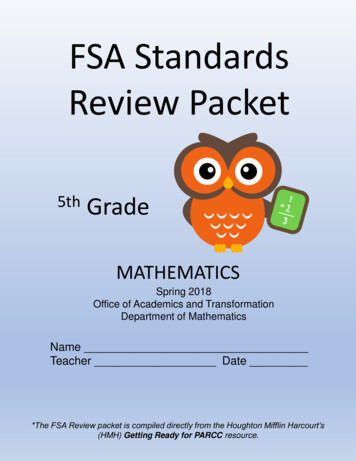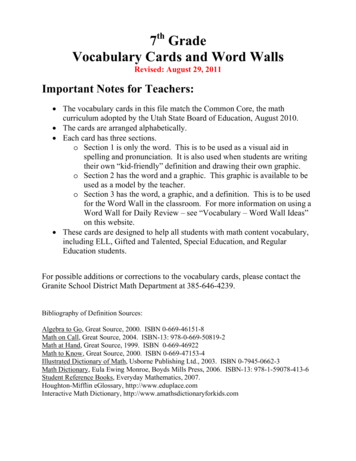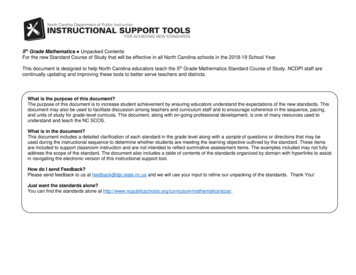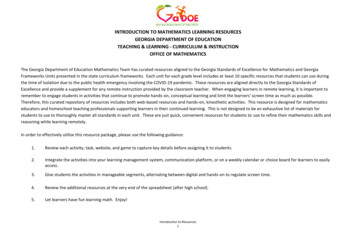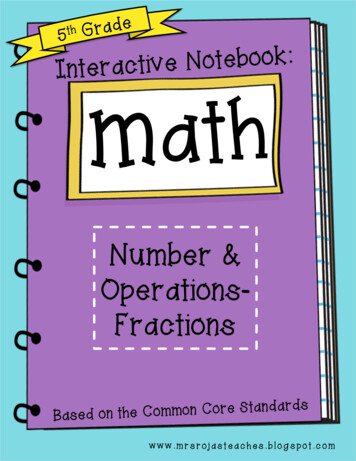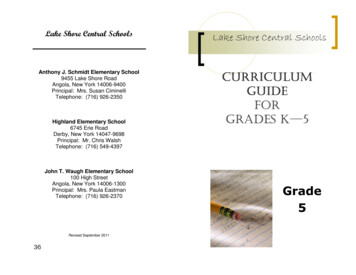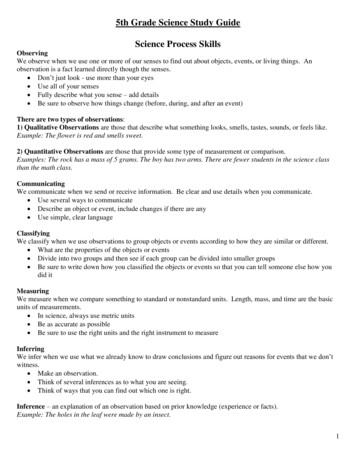
Transcription
5th Grade Science Study GuideScience Process SkillsObservingWe observe when we use one or more of our senses to find out about objects, events, or living things. Anobservation is a fact learned directly though the senses. Don’t just look - use more than your eyes Use all of your senses Fully describe what you sense – add details Be sure to observe how things change (before, during, and after an event)There are two types of observations:1) Qualitative Observations are those that describe what something looks, smells, tastes, sounds, or feels like.Example: The flower is red and smells sweet.2) Quantitative Observations are those that provide some type of measurement or comparison.Examples: The rock has a mass of 5 grams. The boy has two arms. There are fewer students in the science classthan the math class.CommunicatingWe communicate when we send or receive information. Be clear and use details when you communicate. Use several ways to communicate Describe an object or event, include changes if there are any Use simple, clear languageClassifyingWe classify when we use observations to group objects or events according to how they are similar or different. What are the properties of the objects or events Divide into two groups and then see if each group can be divided into smaller groups Be sure to write down how you classified the objects or events so that you can tell someone else how youdid itMeasuringWe measure when we compare something to standard or nonstandard units. Length, mass, and time are the basicunits of measurements. In science, always use metric units Be as accurate as possible Be sure to use the right units and the right instrument to measureInferringWe infer when we use what we already know to draw conclusions and figure out reasons for events that we don’twitness. Make an observation. Think of several inferences as to what you are seeing. Think of ways that you can find out which one is right.Inference – an explanation of an observation based on prior knowledge (experience or facts).Example: The holes in the leaf were made by an insect.1
Predicting/HypothesizingWe predict (make hypotheses) when we make a forecast about what will happen in the future. The prediction isbased on what you already know and data that you have collected. Make observations and measurements (collect data) Look for patterns in what you have observed Make a prediction based on what you know Test your prediction to see if you are right Make a new prediction if you are wrong (Prediction) – tell what will happen next.Example: The Clemson Tigers will win their next football game.2
Science InvestigationA fair test is one in which only one variable is changed or tested.A manipulated (independent) variable is the one factor that is changed or tested by the student doing theinvestigation. Always put it on the x-axis. This is what is changed on purpose by the investigator.Think: ―I‖ in independent variable is what ―I‖ change.A responding (dependent) variable is the result of the changing of the manipulated variable. Always put it on they-axis. Think: ―D‖ in dependent variable ―depends‖ on what ―I‖ change.Controlled variables stay the same or unchanged during the investigation.Steps to an Investigation1.)2.)3.)4.)5.)6.)Question – Ask a question that can be tested.Research - the topicPrediction – What do you predict will happen?Design Your Experiment – Materials and ProcedureRecord and Organize Data – graphs, table, charts.Explain Results– What happened? Compare the results to your prediction.Example of an InvestigationSam sets up an investigation to find out how sunlight affects plant growth. He gives 2 plants the same amount ofwater each day, but he places one plant in the sunlight, and the other plant in the shade. The plant in the sunshinegrows 5 cm taller than the plant in the shade during the 2 weeks of the investigation.The Independent Variable is the location of the plants.The Dependent Variable is the height of the plants.The Controlled Variables include the type of plants and the amount of water.3
How can tools and instruments (including a timing device and a 10x magnifier) be used safely and accurately whenconducting a scientific investigation?Science Tools ChartName of toolWhen usedUnitsmeasuredGraduatedCylinderMeasure volumeof liquidsmlEyedropperMove smallamounts of liquidDrops or mlGraduatedSyringesMeasure volumeof liquidsmlMagnifierMake objectslook largerMeter StickMeasure lengthand widthm and cmRulerMeasures lengthand widthcm and mmCompassTell directionDegrees(N,S,E,W)Pan BalanceCompare mass ofobjectsGrams10 x MagnifierMake objectslook 10 siusTiming DeviceMeasure timeBeakerMeasure volumeof liquidsL and mlForceps /TweezersPick up / holdsmall objectshours,minutes, andseconds4
What safety procedures should be followed when conducting investigations?Safety in Science1.2.3.4.5.6.7.8.9.10.11.Always wear appropriate safety equipment such as goggles or an apron when conducting aninvestigation.Be careful with sharp objects and glass. Only the teacher should clean up broken glass.Do not put anything in the mouth unless instructed by the teacher.Follow all directions for completing the science investigation.Follow proper handling of animals and plants in the classroom.Keep the workplace neat. Clean up when the investigation is completed.Practice all of the safety procedures associated with the activities or investigations conducted.Tell the teacher about accidents or spills right away.Use caution when mixing solutions.Use caution when working with heat sources and heated objects.Wash hands after each activity.The Scientific MethodHow do scientists do what they do?Well, YOU know because you're a scientist, too!Observation is an important part-in fact it's the part at the very start.For it's observation that causes you to wonder whyearthworms do what they do and clouds form in the sky.Your hypothesis is a "best guess" based on what you knowabout how things work--now you're ready to go!Experimentation lets you test the hypothesis you've made-to see if your best guess can make the grade.And because variation is found in nature everywhere,repeated trials should be done, and done with care.And don't forget to decide what variables you'll test.You change the independent variables, but not the rest.Recording your data is very important, too;so you can analyze the results and others can repeat what you do.When you've summarized your results and your experiment is done,you'll have more information about nature and you'll have had some fun.So, now you know that the scientific method is really cool,and that scientists don't just measure--they RULE!5
Technological DesignTechnology is any tool or process designed to help society in some way. Technology applies scientific knowledgein order to develop a solution to a problem or create a product to help meet human needs.Steps in the technological design process include:Identifying a problem or needResearch and gather information on what is already known about the problem or needDesigning a solution or a productGenerate ideas on possible solutions or productsImplementing the designBuild and test a solution or a productEvaluating the solution or the productDetermine if the solution or product solved the problem.The steps of the design can be communicated using descriptions, models, and drawings.A scientific model is an idea that allows us to create explanations of how something may work.Models can be physical or mental.Line Graphs are used to show changes over time.To construct a line graph the following steps should be followed: Draw a horizontal line (x-axis) and a vertical line (y-axis) that meet at a right angle. Identify the independent (manipulated) variable and the dependent (responding) variable from thedata. The independent (manipulated) variable is written on the x-axis. The dependent (responding) variable is written on the y-axis. Include appropriate units of measurement for each variable. Look at the range of data (lowest and highest) to determine the intervals or increments (numbers onthe x-axis and the y-axis). The increments do not need to be the same for both the x-axis and the y-axis, but should beconsistent on either axis. Label the point at the right angle as zero (0).Plot the data on the graph as matched pairs. For example, every independent (manipulated)variable number will have a corresponding dependent (responding)variable number.Connect the points on the line graph.Write an appropriate title for the graph that contains the names of both variables.DRY represents Dependent-Responding-Y-axis.Y-axisMIX represents Manipulated Independent-X-axis.DRYX-axis·MIX6
Properties of MatterMatter is anything that takes up space and has mass.It is made of very small particles.Physical Properties of matter include volume, shape, and the movement and spacing of particles.GasLiquidSolidGases· Gases have no definite shape or volume, but take the shape and volume of their containers,filling the space available.· The particles easily move far apart from each other and spread out through the availablespace.Liquids· Liquids have a definite volume, but take the shape of their containers.· The particles are also close to one another, but they are able to move apart from each otherand flow from place to place.· The volume of a liquid can be measured using a graduated cylinder or graduated syringe.Solids· Solids have a definite shape and volume.· Particles in a solid are very close to one another (dense) and vibrate, but stay in the sameplace.· The volume of a solid with rectangular sides can be determined by measuring with a rulerand multiplying height x width x length.· The volume of an irregularly shaped solid can be determined by water displacement in agraduated cylinder.· The volume of water displaced equals the volume of the object.7
Mixture: a combination of two or more substances These substances are not permanently combined. They can be separated from the mixture and be thesame as they were before mixed.Solution: a mixture in which all parts are mixed evenly One part dissolves but the solution can be separated backinto the separate substances.RememberA solution is a type of mixture, but not all mixtures are solutionsThe greatest amount of a substance in a solution is called the Solvent (usually a liquid)The smallest amount of a substance in a solution is called the Solute (usually a solid).In the Kool-Aid solution, the powder is the solute and the water is the solvent.A way to remember solvent and solute: solvent has more letters than solute and the solvent isusually the greatest part of a solution.Concentration: determined by the amount of solute in the solventThe more solute a solution has compared to the amount of solvent, the more concentrated it is said tobe When two solutions contain the same amount of solvent, the one with the greater amount of solute isthe more concentrated solution.In order to make a solution more concentrated--more solute is added.To make a solution less concentrated—more solvent is added.RememberThink about the Kool-Aid. The more powder you add to the water the sweeter it will taste – moreconcentrated.If the Kool-Aid is too sweet, add more water to make it less concentrated.Sometimes when 2 or more substances combine they form a NEW substance with differentproperties.Examples:· To make a cake, you can mix flour, water, egg, oil, and sugar, but after baking in the oven, the cakehas different properties.· Adding vinegar to baking soda will produce a gas.· When steel wool is exposed to water, rust is formed.8
Use the processes of filtration, sifting, magnetic attraction, evaporation, chromatography, andfloatation to separate mixturesFiltration is used to separate solid particles from a liquid.· For example, pouring the mixture through a filter paper in a funnel will trap the solid particles andonly allow the particles of the liquid to pass through. This method is used in water treatment plantsas part of the process for separating dirt and other solid particles from water to produce cleandrinking water.Sifting is used to separate smaller, solid particles from larger solid particles.· For example, the mixture of different sized solid particles can be put into a container that hasa screen material at the bottom with holes of a certain size. When the mixture is shaken, the smallerparticles go through the screen leaving the larger particles in the container.· Cooks sift flour to get a small particle size for baking leaving larger particles of flour in the sifterabove thescreen.Magnetic attraction is used to separate magnetic material from a mixture of other substances.· When a magnet is stirred through the mixture, it pulls out the magnetic material from the mixture.· A cow magnet, for example, is given to a cow to swallow. It stays in the first stomach of thecow keeping magnetic materials like wire and other harmful materials that cows swallowfrom going into the rest of their digestive system.Evaporation is used to separate a solid that has dissolved in a liquid solution. The solution is heatedor left uncovered until all the liquid turns to a gas (evaporates) leaving the solid behind.· Salt in salt water or ocean water, for example, is separated by heating the solution until allthe water evaporates leaving the solid salt in the container.Chromatography is used to separate and analyze the solutes in a solution.· For example, a small amount (2-3 drops) of the solution is put on a piece of filter paper,which is put in a solvent. · The substances in the solution that dissolve most easily travel thefurthest; andsubstances that do not dissolve easily do not travel very far.· The bands of color that are formed allow scientists to identify the substances in the solution bycomparing themto the location of known substances forming bands of color on different filter papers.Floatation is used to separate solids that float from the remaining liquid in a mixture.· The solids are stirred and when they float to the top, they are skimmed off the surface of theliquid and put into a different container. Pepper can be separated from water by floatation.Rate of dissolving is the amount of time a solute takes to dissolve in a solvent.Temperature change, particle size, and stirring can affect the rate of dissolving.Temperature changeUsually, if the temperature increases, more of the solute will dissolve faster.Particle sizeUsually, if the particle sizes are smaller (crushing or breaking apart), more of the solute willdissolve faster.StirringUsually, if the solution is stirred, more of the solute will dissolve faster.Water, Air, and Soil PollutionBecause substances can mix with and dissolve in water, air, and soil, pollution can occur that harmsour environment.9
Forces and MotionA force is a push or a pull. Forces make things move faster, slower, stop, or change directions.Types of ForcesMagnetism A force that acts at a distance and cannot be seen. Materials that create this force are said to be magnetic and are called magnets. The needle of a compass moves because of Earth’s magnetism. · When like poles (S-S or N-N) of magnets are near each other, the magnetic force causes thepoles to repel, and the magnets push away from each other. When opposite poles: north pole and south pole (N-S or S-N) of magnets are near each other,the magnetic force causes the poles to attract, and the magnets pull toward each other. The closer the objects, the greater the magnetic force. The magnetic force is greatest at the poles of magnets.NNSSOpposite poles attractNSSNLike poles repelSNNSGravity· A pull that attracts objects to each other.· This attraction is not noticeable unless one of the objects is very large, for example a planet,moon, or the Sun.· The force of gravity between Earth and anything on it is extremely noticeable because themass of Earth is so large. The pull of Earth’s gravity makes any object fall to the ground.· As the Moon goes around Earth, its gravity pulls on Earth causing water in the oceans tomove toward the Moon.· Earth’s gravity also pulls on the Moon. This force of gravity keeps the Moon moving aroundEarth.· Similarly, the pull of the Sun’s gravity keeps Earth moving around the Sun.Friction· The force that tries to stop motion between two surfaces that are touching.· The effect of friction can be observed as an object slides across a surface and slows down.· The rougher the surfaces are, and the harder the surfaces press together, the more frictionthere will be.· Friction can be reduced by using Lubrication (oil, wax, or grease). Rollers can also reduce friction.· Without friction, it would be very hard to slow or stop the motion of objects.10
Three ways the effect of friction on moving objects can be changed.1. Texture of the surface· Rough surfaces tend to create more friction.· Smooth surfaces tend to create less friction.2. Amount of surface area· The amount of surface area affects the friction between objects in liquids and gases.· The amount of surface area affects the friction on a moving object under the followingcircumstances: air resistance (such as the size of a parachute)or the resistance of an object asit glides through water (such as a boat).· The amount of surface area in contact usually does not affect friction between two solids.3. Lubrication· Lubrication, for example oil or grease, reduces the effects of friction.· Without lubrication, moving parts of machines would slow down or stop very quickly.The motion of an object can be explained by describing the position, direction, and speed.Position· The position of an object is its location relative to another object (the reference point) for example―above‖, ―below‖, ―beside‖, ―behind‖, ―ahead of‖ plus the distance from the other object. Thedistance (length) from the reference point changes when the object moves.Direction· Direction of motion is the course or path that an object is moving and can be determined by readinga compass using the terms ―north‖, ―south‖, ―east‖, or ―west.‖ Direction can also be described usingthe terms ―right‖, or ―left,‖ ―forward,‖ or ―toward‖ relative to another object, or ―up‖, or ―down‖relative to Earth.Speed· A measure of how fast an object is moving.Unbalanced forces affect the rate and direction of motion in objects.Unbalanced Forces cause changes in motion (will cause an object to start, speed up, slow down,stop, or change its direction).Balanced Forces do not change the motion of objects. The forces are equal in strength butopposite indirection.Balanced forceUnbalanced forceBoth sides are pulling equally causingno change in motion.Rate of motion is the speed of the object or how fast or slow the object is moving.· Unbalanced forces can change the rate or direction of motion of an object in different waysObject at rest· If an unbalanced force acts on an object at rest the object will move in the direction of theforce. A stronger force (push or pull) will make it move faster.11
Object in motion· If an object is moving, an unbalanced force will change the motion of the object in differentways depending on how the force is applied. The unbalanced force may speed the object up,slow it down, or make it change directions. If the force is applied in the same direction as the object is moving, the object will speedit up. If the force is applied in the opposite direction as the object is moving, the object willslow it down or stop it. If the force is applied to the side of the moving object, the object will turn.A change in forces or a change in mass affects the motion of an object.Force If there are two objects with the same mass and one is acted on by a greater force than theother, the one acted on by the greater force will have the greatest change in speed. It will speed up the most or slow down the most in a given amount of time.Mass If there are two objects, one with a greater mass than the other, and the same amount of forceis applied to each object, the object with the lesser mass will have the greater change in speed. It will speed up or slow down more in a given amount of time. It is harder to change the speed of the object with the greater mass than the object with thelesser mass.Line graphs are used to show the motion of an object. Look at the data collected in the chartbelow and see how it is used to create a graph.12
Use the distance line graph to determine: Distance the object traveled after a certain amount of time Distance the object travels during a particular time interval If the object is moving or stationary during a particular time intervalCompare the motion of the objects on the graphs below to determine if the object is movingfaster or slower during different time intervals.13
Landforms and OceansEarth’s oceans and land can be affected in constructive ways and destructive ways by natural processes.Constructive - Processes that create landforms (deposition, landslides, volcanic eruptions, floods)Destructive - Processes that destroy landforms (weathering, erosion, landslides, volcanic eruptions,earthquakes, floods)Natural processes that can affect Earth’s oceans and land include:WeatheringWeathering is a term used to describe processes that break down rocks at or near thesurface of the earth.Weathering can be either physical or chemical.These processes cause the surface of the earth to dissolve, decompose, and break into smaller pieces.Weathering can be caused by: Water Plants (roots break apart rocks) Temperature changes (water freezes in cracks of rocks)ErosionErosion is the movement of sediments and soil by wind, water, ice, and gravity.DepositionDeposition is the dropping, or depositing, of sediments by water, wind, or ice. It builds new land on Earth’ssurface, like a delta at the end of a river or the pile up of a sand dune in the desert. Shells on the beach aredeposition by ocean waves.Deposition begins with a “D” and Dunes and Deltas begin with a “D”.Chant:Weathering will break rocks downErosion moves it all aroundPut it here and then we’re doneNow we have deposition14
LandslidesLandslides are mass movements of land due to gravity.Landslides can cause buildings to fall, or power and gas lines to break.Landslides even occur on the continental slope in the ocean.Volcanic eruptionsVolcanoes are mountains with openings in Earth’s crust through which magma, gases, andash reach Earth’s surface.When the magma erupts from the volcano the top of the mountain can be changed, eitherbuilt up or exploded off.The lava and ash can destroy forests and bury fields.Volcanic eruptions can even change Earth’s weather patterns.Volcanic eruptions also occur under the oceans; these volcanoes that are built up are calledSeamounts. If the seamount rises above the ocean surface it is called a volcanic island (for exampleHawaii or Japan).EarthquakesEarthquakes are vibrations on Earth’s surface caused by sudden movement in the Earth, oftenalong a fault, a break in Earth’s surface.Some earthquakes cause little damage and some cause a lot of damage.Large earthquakes can cause landslides.Earthquakes under the ocean can cause huge waves, called tsunamis that destroy land andcause great damage if they come ashore.FloodsFloods occur when a large amount of water covers land that is usually dry.When the flood occurs; rapid erosion can take place and move soil and sediments away.When the flood recedes; new sediment is left behind and can build up rich soil deposits.15
Landforms of the Ocean FloorContinental shelfThe edges of the continents slope down from the shore into the ocean.The part of the continent located under the water is known as the continental shelf.The width of the continental shelf can vary.In some places the continental shelf is fairly shallow and in other place it becomes very deep,but it is not the deepest part of the ocean.Continental slopeThe steep slope where the continental shelf drops to the bottom of the ocean floor is calledthe continental slope. The depth of the ocean water increases greatly here.Mid-ocean ridgeOn the bottom of the ocean, there is a central ridge, or mountain range, that divides the oceanfloor into two parts called the mid-ocean ridge.Volcanic mountains not formed on the mid-ocean ridge are called seamounts.Rift zoneIn the center of the highest part of the mid-ocean ridge is a narrow trench called a rift.Underwater volcanic activity that adds mountains to either side of the mid-ocean ridge occursat the rift zone .TrenchesThere are many steep-sided canyons and deep, narrow valleys in the bottom of the ocean.Ocean trenches are the deepest part of the ocean basin and are deeper than any valley foundon land.Ocean basinLocated on either side of the mid-ocean ridge is the ocean basin.It is made up of low hills and flat plains.The flat area of the ocean basin is called the abyssal plain .Seamounts are generally formedon the ocean basin.16
Continental and Ocean LandformsDescriptionLow land between hills ofmountainsDeep valley with high steep sidesAn opening in the surface fromwhich lava flowsLand which rises high above thegroundWide, Flat areas of oSeamount and volcanic islandsMountain rangeMid-ocean ridgePlainsAbyssal Plains17
The area where the ocean meets the land is called the Ocean Shore Zone.Waves, currents, tides, and storms can affect the geologic features of the ocean shore zone. Some shorelines are rocky. Shorelines made of sand are called beaches. Shorelines are always changing because of wind and water. Waves can wear away the land and expose a rocky shore or the waves candeposit sand along the shore and form a beach. If the waves reach the beachat an angle, the sand is moved along the coast. Currents, called longshore currents, along the shoreline can move sand from one location toanother. Tides can bring in sand, shells, and ocean sediments at high tide and leave them behind whenthe tide goes out. Storms can cause wave action that removes sand from beaches.Barrier islands Islands are pieces of land surrounded by water on all sides. Islands with sandy beaches arecalled barrier islands. These barrier islands protect the mainland from the effects of waves on its shore. As the waves deposit sand on the beaches, the shapes of the barrier islands change. Currents can move the sand from one end of the island to the other.Estuaries All rivers flow into the oceans. The area where a river meets the ocean is known as an estuary. Estuaries have a mixture of freshwater and saltwater. Waves can deposit sand in the estuaries. At high tide, ocean water brings in sediments and sea life that feed and nourish life in theestuary.Inlets Inlets are the water-filled spaces between the barrier islands. As the tides change, the amount of water in the inlet will change. Ocean currents and storms can change the shape of an inlet opening.Large storms, for example hurricanes, can also cause massive construction or destruction of beaches, barrierislands, estuaries, and inlets because they produce high waves, storm surges, and winds.18
Water can be moved by waves, currents, and tides.Waves The repeated movement of water is known as a wave. All waves have the same parts. The highest part is known as the crest and the lowest part isknown as the trough . Most ocean waves are caused by winds that are blown across the surface of the water. A wave changes shape when it reaches the shore. As the top of the wave curls over it forms a breaker. Sometimes giant sea waves, called tsunamis, are caused by underwater earthquakes, volcaniceruptions, or landslides.Currents Flowing streams of water that move continually through the ocean in a specific direction arecalled currents . Some currents flow at the ocean’s surface and some are found deeper in the ocean. Surface currents are caused by the movement of Earth and by the force and direction of wind. The movement of Earth and winds causes these currents to flow along curved paths. Warm water and cold water are moved to different regions on Earth as a result of currents. Warm surface currents are driven by Earth’s rotation from the tropics to higher latitudes. Cold surface currents are driven by Earth’s rotation from the polar latitudes toward the equator.Tides Several times during the day, the level of water at the ocean shore changes. This regular rise and fall of waters in oceans and seas is called a tide. Tides are caused by the pull of the Moon’s gravity on Earth. As the Moon moves in relation to Earth, the water on Earth moves too. As Earth spins on its axis, the part of the ocean facing the Moon will bulge. High tide occurs when the water level is at its highest point. Low tide occurs when the water level is at its lowest point. Tides rise and fall about twice a day.19
Human Activity can affect the land and oceans of Earth.Humans can help protect the land and oceans by preserving the natural resources these areas provide.Examples of natural resources include: air, water, trees, rocks, minerals, soil, coal, and oil.Using resources wisely is call conservation. Ways to conserve our resources include: Prevent pollution Reduce, Reuse, Recycle Clean-up projects Beach renourishment projects to protect sand on beaches Plant trees, bushes, and trees to improve air quality and keep erosion from carrying away soilPollution is anything that harms the natural environment.Human activities that can pollute the environment include: Dumping materials from industry, mining, or agriculture onto the land or into the water Careless dumping of trash on land or in oceans Smoke from burning fuels pollutes the air Oil spills harm the oceans20
CellsThe cell is the smallest unit of living material having major structures within it allowing it to live.Some organisms are just one cell.Most
3 Science Investigation A fair test is one in which only one variable is changed or tested. A manipulated (independent) variable is the one factor that is changed or tested by the student doing the investigation. Always put it on the x-axis. This is what is changed on purpose by the investigato

